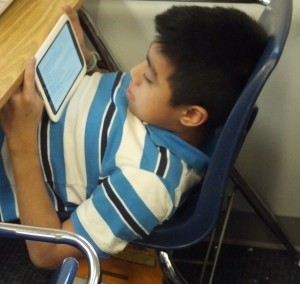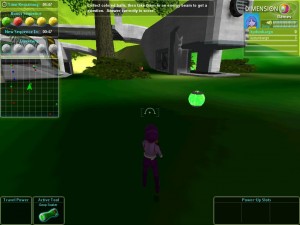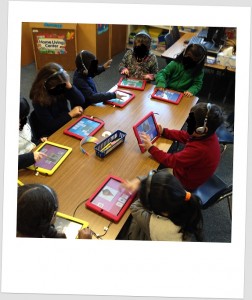More and more eReaders are becoming the go-to devices for  readers everywhere. We love the ability to carry 50 books at time with us on the airplane, to never lose our place because our bookmark fell out and to search names of characters to find when they were first introduced. The English Language Arts department at George Washington Middle School wanted their students to have these same advantages. In the winter of 2013-2014, a 6th grade co-taught Special Education and General Education class began using Nooks for the first time.
readers everywhere. We love the ability to carry 50 books at time with us on the airplane, to never lose our place because our bookmark fell out and to search names of characters to find when they were first introduced. The English Language Arts department at George Washington Middle School wanted their students to have these same advantages. In the winter of 2013-2014, a 6th grade co-taught Special Education and General Education class began using Nooks for the first time.
The immediate reaction was more than positive. Students loved the layout of the device and had fun discovering all the features available to them. We all love to personalize our devices and Nooks are no different. Students learned (and taught each other) how to change the background image, adjust the font size to suit them and even adjust the orientation to the style they liked best. The ability to make a book their own was a new experience, and it makes a difference, having a book that you can change and modify increases student ownership in the device and increases their interest in reading the text.
 Beyond the personalization of Nooks, students were able to practice a number of different during reading strategies. Students can highlight passages that they find significant, much the way readers in a book club will underline sections they want to share of come back to. Students can also use the embedded dictionary to look up words they don’t know. For reluctant readers, the ability to find out the definition of new words without asking the teacher or physically using a dictionary (and thus showing the whole class you don’t know the word) is a gift. Watching the students read on their Nooks, you can see them smoothly using all these techniques and empowering themselves to be better readers.
Beyond the personalization of Nooks, students were able to practice a number of different during reading strategies. Students can highlight passages that they find significant, much the way readers in a book club will underline sections they want to share of come back to. Students can also use the embedded dictionary to look up words they don’t know. For reluctant readers, the ability to find out the definition of new words without asking the teacher or physically using a dictionary (and thus showing the whole class you don’t know the word) is a gift. Watching the students read on their Nooks, you can see them smoothly using all these techniques and empowering themselves to be better readers.
As this first class tests out the Nooks and we see the progress they are making, we look forward to expanding the use of the Nooks to more classes and for more novels. Students will be able to check out eBooks from the school library and the public library. We will be able to load novels that specifically match individual student lexile levels and increase their access to non-fiction texts. As we move forward, these devices will continue to give students access to relevant devices, literacy skills and personalized details which increases their interest and engagement with a wide variety of texts.


